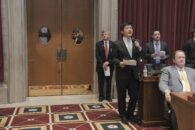By Stephen R. Miller, MHTC Chairman
The recovery from the Great Recession of 2008 has resulted in increased economic activity in Missouri and an increase in general revenues. So why not just dip into general revenue to address our transportation funding needs – and avoid increasing fees or taxes?
It is not the province of this Commission to determine how transportation will be funded; only to educate regarding the need and to use wisely the revenues received. But, as part of our obligation to educate we have a duty to speak clearly regarding what revenue sources work best and why.
Transportation funding is complicated. And operating a 34,000-mile highway system costs much more than many people would expect (e.g. over $1 million to build one mile of just one lane of interstate highway; $46 million budgeted annually for snow removal, $23 million per year for mowing.) The planning process can take well over a decade: identifying the need, public discourse on the solution, acquisition of right of way, design, public bids and construction.

Local jurisdictions and political leaders work annually with MoDOT professionals in each of the seven MoDOT districts to assemble a transportation improvement program for a five-year period. So right now, they are working to develop the regional programs for 2017-21. Seven programs emerge from the process and are rolled into a state transportation improvement program (STIP) which is reviewed by senior management and then ultimately presented to the Commission for approval. We review the draft in May and typically approve it in July following a public comment period.
When the Commission approves the STIP, it makes a commitment to Missourians that the project will be built – no unfulfilled promises. In order to make this commitment, the Commission must rely on financial projections of the funds that will be available over the next five years and beyond.
Because our ability to plan for the future relies upon a predictable source of revenue, you have heard us emphasize the importance of long-term funding. Short-term fixes – or revenue that may be available one year and gone the next – wreak havoc on planning.
That’s why for decades, federal funding for transportation was subject to six-year programs, thereby allowing planners to more accurately project future revenues and plan accordingly.
The last six-year federal program ended in 2011. Since then Congress enacted 37 different extensions of funding. As the original program ended planners wondered what, if any funding, would be next. And, that process repeated itself over and over again. As a result, planners had to walk a tightrope: how to keep transportation programs moving forward without promising projects for which there would be no funding. In Missouri, this precarious situation was exacerbated by a lack of state funding.
To make matters worse, federal funding comes in the form of reimbursements, meaning that a state must first spend the money, by paying contractors for instance, and then seek reimbursement from the federal government. A delay in one of these extensions could cause a cash flow crunch for a state DOT.
Keeping the public trust was essential, so MoDOT did two things to avoid getting caught short. The STIP was programmed conservatively. First, years 4-5 of each STIP were not fully programmed; a full complement of projects was not put on the list in outer years to guard against making a commitment that could not be honored. Second, to better assure that those projects in the STIP could be completed if there was a “hiccup” or interruption in funding, MoDOT held cash in its operating account as a kind of “rainy day fund” which could be available to dip into if Congress failed to come through with the same level of funding to construct a project on the STIP or to provide cash flow if reimbursement funds were delayed.
The recent enactment of a funded five-year federal program – the FAST Act – has allowed the Commission to authorize filling out more completely the STIP which is being prepared for 2017-21 and to pay down some of those cash reserves. The Commission acted at our last meeting to set this planning process in motion.
What does this have to do with the type of state transportation funding that should be considered? Dipping into general revenues this year is equivalent to those short-term funding extensions at the federal level. General revenue funding for a year does not allow planners to plan as they should, because there is no guarantee that the same level of funding will be available the next year, or the year thereafter, or the year after that.
For instance, we have said that $160 million dollars in new state funding is needed to adequately operate and maintain the existing highway network; make progress on bridge conditions and reinstitute the cost-share program to encourage transportation projects that foster economic development. That is an annual figure. SB 623, currently on the Senate floor awaiting debate, would yield approximately $56 million annually for state transportation needs. The amount could fluctuate a little each year based upon the number of gallons of fuel consumed, but for planning purposes this represents a relatively reliable long-term funding source. The monies are constitutionally protected from being diverted for other purposes and will recur year after year. If this year’s legislature would appropriate the same $56 million – or less – from the general fund it would be assured for only one year. This legislature cannot bind future legislatures which could decide to provide no general revenue funding next year – and so on. Further, dipping into general revenue pits transportation against other state funding needs, making the outcome even more uncertain.
For planning purposes and for the long-term health of the system one revenue source is clearly preferable over the other.
Not all revenue sources are created equal. In choosing how to fund transportation it is important to choose wisely.
Let’s get it done, but let’s be smart about how we do it.




